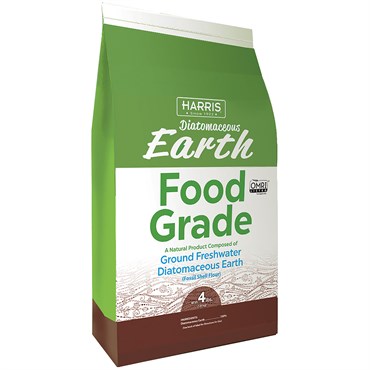Description
100% ground freshwater diatomaceous earth with absolutely no additives or fillers. Harris Diatomaceous Earth Food Grade 4lb powder is listed with the Organic Materials Review Institute and is composed of ground freshwater diatomaceous earth mined in Nevada and packaged in Georgia.
-
Pest Control: Diatomaceous earth is abrasive and contains sharp, microscopic edges that can physically damage the exoskeletons of insects. The main active component in diatomaceous earth, from an insecticidal and pest control perspective, is the amorphous silica. This silica has abrasive properties that can damage the exoskeletons of insects, leading to their dehydration and death. As such, food-grade diatomaceous earth is often used as a natural, non-toxic pesticide in gardening and agriculture. When insects come into contact with DE, it can dehydrate and kill them. DE is effective against a variety of pests such as ants, aphids, beetles, mites, and more. It's considered an organic, non-toxic pest control option.
-
Fungal Control: DE can help control certain fungal diseases when applied as a dust on plant foliage. It can absorb moisture from the spores and mycelium of fungi, thereby inhibiting their growth and spread. However, its effectiveness against fungal diseases may vary depending on the specific type of fungus and environmental conditions.
-
Detoxification of Soil: Diatomaceous earth can help absorb and immobilize heavy metals and certain toxic substances in the soil, preventing their uptake by plant roots. This property can be beneficial in soil remediation efforts to reduce the impact of soil contaminants on plant health.
-
Improving Soil Drainage: When mixed with soil, DE can help improve soil drainage in clayey or compacted soils. Its porous structure allows water to pass through more easily, preventing waterlogged conditions that can harm plant roots.
-
Natural Amendment: Diatomaceous earth contains trace minerals like silica, which can be beneficial for plant growth. While it doesn't provide major nutrients like nitrogen, phosphorus, or potassium, it can contribute to the overall mineral content of the soil.
When using diatomaceous earth in gardening or agriculture, it's important to follow these guidelines:
-
Use Food-Grade DE: Ensure you are using food-grade diatomaceous earth, which is safe for use around plants, humans, and pets. Industrial-grade DE, used in pool filters and other applications, may contain additives that can be harmful if ingested or inhaled.
-
Apply in Dry Conditions: Apply DE when the foliage and soil are dry to maximize its effectiveness as a pest control method.
-
Reapply as Needed: DE may need to be reapplied after rain or irrigation, as it can become less effective when wet. Reapplication may also be necessary to combat ongoing pest infestations.
-
Wear Protective Gear: When applying DE as a dust, wear protective gear such as a mask, goggles, and gloves to avoid inhaling or getting it in your eyes.
Overall, diatomaceous earth can be a useful tool in an integrated pest management strategy and may have additional benefits related to soil and plant health, depending on your specific needs and conditions.
Diatomaceous earth (DE) is primarily composed of the fossilized remains of diatoms, which are microscopic, single-celled algae. The chemical composition of diatomaceous earth can vary somewhat depending on its source, but it primarily consists of the following elements and compounds:
-
Silicon Dioxide (SiO2): This is the most abundant component of diatomaceous earth, typically making up about 60-80% of its composition. It exists in the form of amorphous silica.
-
Aluminum Oxide (Al2O3): Aluminum oxide is another common component, usually present in smaller amounts, typically around 10-15%.
-
Iron Oxide (Fe2O3): Iron oxide can be present in trace amounts in some types of diatomaceous earth.
-
Calcium Oxide (CaO): Depending on the source, some diatomaceous earth products may contain small amounts of calcium oxide.
-
Magnesium Oxide (MgO): Similar to calcium oxide, magnesium oxide may be present in minor quantities.
-
Other Trace Minerals: Diatomaceous earth can also contain trace amounts of other minerals and elements, including potassium, sodium, and titanium, among others.
-
Organic Matter: Depending on the source and processing of diatomaceous earth, it may contain small amounts of organic matter, including remnants of diatom cell walls and other organic materials.

